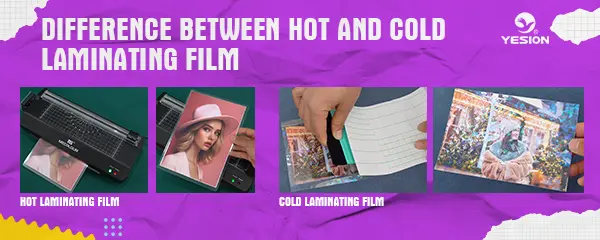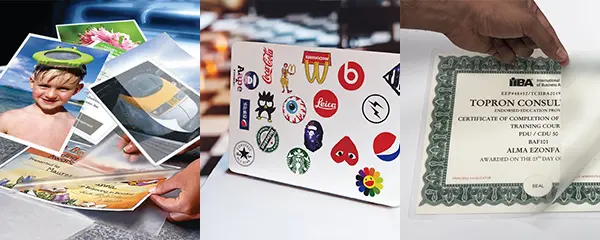
What is cold laminating film for?
2025-01-07
Types of Cold Laminating Film
2025-01-14When it comes to laminating printed materials, both hot and cold laminating films serve essential roles, offering distinct advantages depending on the specific needs of the user. Understanding the difference between hot and cold laminating film is crucial for selecting the right option for your project. In this article, we will explore the key differences, benefits, and applications of hot and cold laminating films to help you make an informed choice.
What is Hot Laminating Film?
Hot laminating film is designed to be used with a heat-activated adhesive. The laminating process involves passing the material and film through a heated laminator. The heat activates the adhesive on the film, allowing it to bond firmly to the surface of the printed material.
How Hot Laminating Film Works
The process of hot lamination requires specialized equipment—a laminating machine that generates the heat necessary to melt the adhesive. The printed material is inserted into the laminating pouch, which is then heated to a high temperature. As the material and film pass through the machine, the heat causes the adhesive on the film to bond with the printed item. Once cooled, the adhesive hardens, creating a durable and permanent protective layer.
Common Uses of Hot Laminating Film
- Documents and Certificates: People commonly use hot laminating for documents that require a permanent, durable finish, such as legal certificates, diplomas, and ID cards.
- Menus and Price Lists: Restaurants and retailers frequently use hot laminating for menus and price lists to ensure durability and resistance to spills and wear.
- Large Format Prints: Hot lamination works well for larger prints, such as posters, banners, and photographs, where high-quality, permanent lamination is necessary.
Uses of Hot Laminating Film
What is Cold Laminating Film?
Cold laminating film, unlike hot laminating film, uses a pressure-sensitive adhesive that does not require heat. Cold lamination involves applying pressure to bond the film to the printed material.
Common Uses of Cold Laminating Film
- Photos and Artwork: Cold laminating is often used for protecting photographs, artwork, and other heat-sensitive materials that may be damaged by high temperatures.
- Promotional Materials: Flyers, brochures, and other promotional materials are frequently cold-laminated to enhance their durability and appearance.
- Documents for Temporary Use: Cold laminating is ideal for documents that require temporary protection or shorter-term usage, such as business cards, tickets, and instructional guides.
Uses of Cold Laminating Film
Related:
What is cold laminating film for?
Key Differences Between Hot and Cold Laminating Film
While both hot and cold laminating films offer protection for printed materials, their differences lie primarily in the application process, the types of materials they can handle, and the final results. Below are the key distinctions:
1. Heat Requirement
- Hot Laminating Film: Requires heat to activate the adhesive. This process involves a heated laminating machine that melts the adhesive, allowing it to bond with the material.
- Cold Laminating Film: Does not require heat. The adhesive is pressure-sensitive and adheres to the material when pressure is applied.
2. Application Process
- Hot Laminating Film: The laminating process requires the use of a heated laminating machine that generates heat to bond the film to the printed material.
- Cold Laminating Film: You apply the film manually or with a cold laminating machine. The process involves no heat, only pressure to secure the adhesive to the material.
3. Material Compatibility
- Hot Laminating Film: Ideal for materials that can withstand heat, such as paper, cardstock, and certain types of photo prints. However, it is not suitable for heat-sensitive materials, such as delicate artwork or photographs with special inks.
- Cold Laminating Film: Best for heat-sensitive materials, including photographs, fine art prints, and certain inks that may smudge or discolor when exposed to high temperatures.
4. Durability and Protection
- Hot Laminating Film: Provides a more permanent, durable, and long-lasting finish. The bond created by the heat-activated adhesive is stronger, making it more resistant to tearing, moisture, and UV degradation.
- Cold Laminating Film: Although it offers a solid protective layer, the adhesive bond is generally not as strong as hot lamination. It is more suitable for temporary or short-term use but can still provide adequate protection against dirt and moisture.
5. Speed and Convenience
- Hot Laminating Film: The process of hot lamination tends to take longer due to the heating and cooling phases. The laminating machine needs to warm up before use, and the material may require additional cooling time.
- Cold Laminating Film: Cold lamination is generally faster and more convenient since no heat is required. It can be done quickly and efficiently, even without a laminating machine, making it an ideal option for smaller projects or quick tasks.
6. Cost
- Hot Laminating Film: Often involves a higher upfront cost due to the specialized heat laminating machines, which can be an investment for businesses requiring large volumes of lamination.
- Cold Laminating Film: Typically more cost-effective as cold laminators are usually less expensive than their hot laminating counterparts. This makes cold lamination an attractive option for smaller businesses or individuals who don’t need to invest in expensive equipment.
7. Finish and Appearance
- Hot Laminating Film: Often results in a shinier, glossier finish that enhances the vibrancy of colors and provides a professional, high-quality look. This is particularly beneficial for marketing materials and signage.
- Cold Laminating Film: The finish of cold laminating film is generally less glossy, providing a more muted, matte appearance. However, many people prefer matte and textured finishes for projects that require a less reflective surface.
When to Use Hot Laminating Film vs. Cold Laminating Film
Choosing between hot and cold laminating film depends on the specific needs of the project:
Use Hot Laminating Film if:
You need a more durable, long-lasting finish.
The material is heat-resistant and can withstand high temperatures.
You are laminating large volumes of items, such as documents, photos, or signage.
You want a glossy, professional finish that enhances the colors of printed materials.
Use Cold Laminating Film if:
You need to laminate heat-sensitive materials, such as photographs or artwork.
A fast, simple, and convenient laminating solution for smaller projects.
You are working with materials that may not be suitable for heat (e.g., certain types of ink, paper, or plastic).
You prefer a matte or non-glossy finish for a more subdued look.
Both hot and cold laminating films are essential tools in the printing and graphics industries, offering distinct advantages depending on the type of material and the desired outcome. Hot laminating provides a durable, high-quality finish, while cold laminating offers flexibility, speed, and ease of use for heat-sensitive items. By understanding the differences between the two, you can select the most suitable lamination method for your needs.



